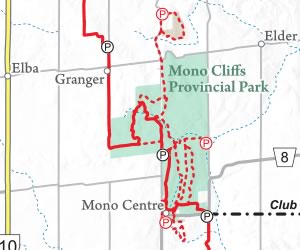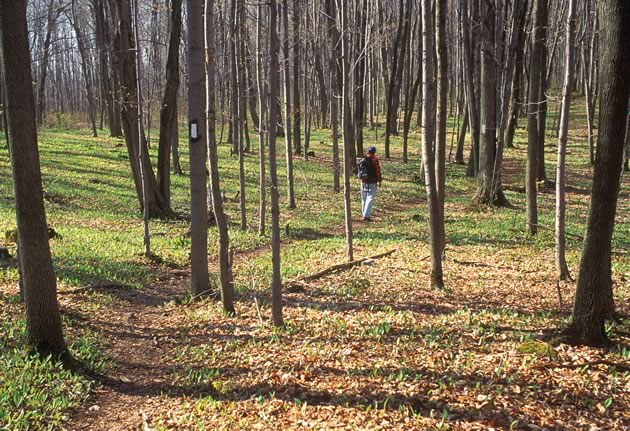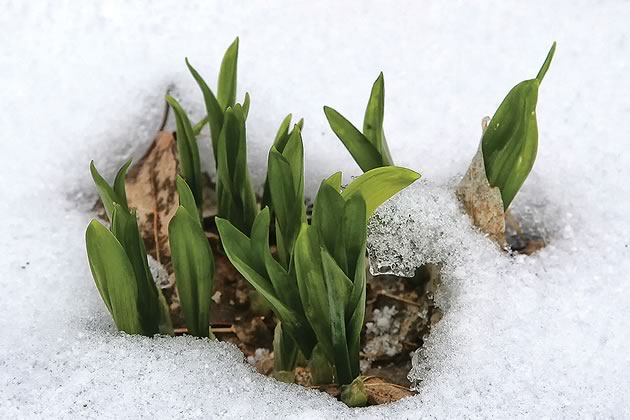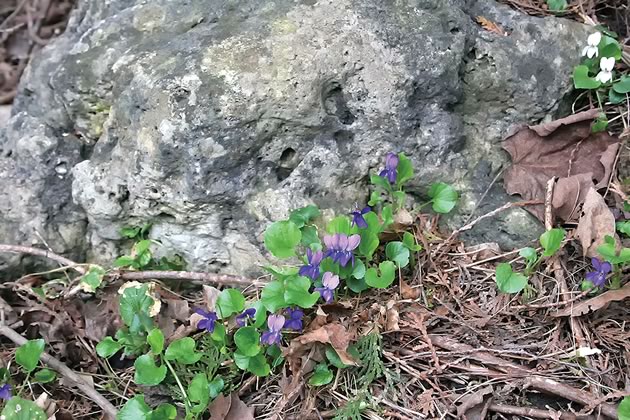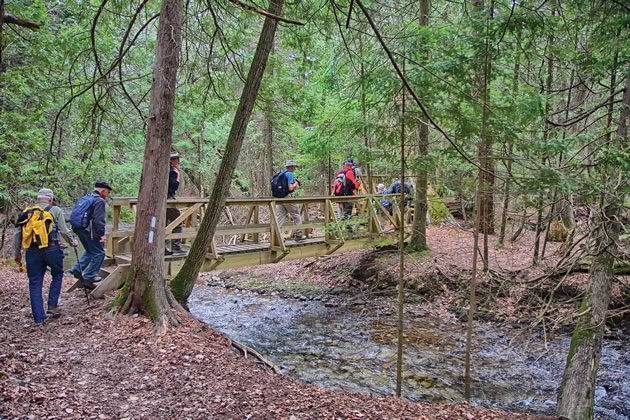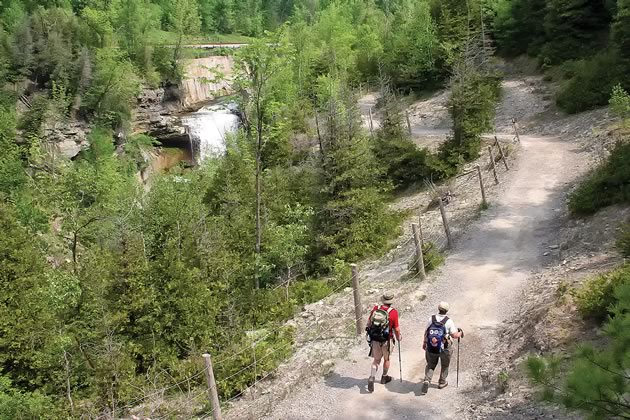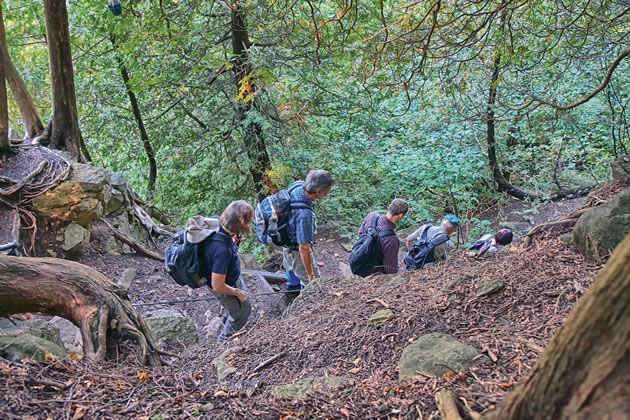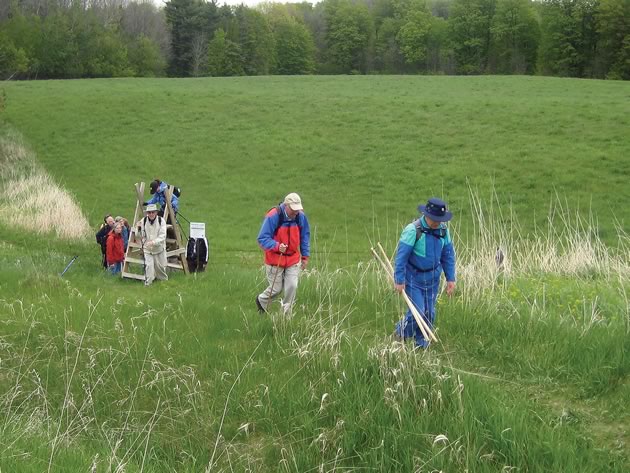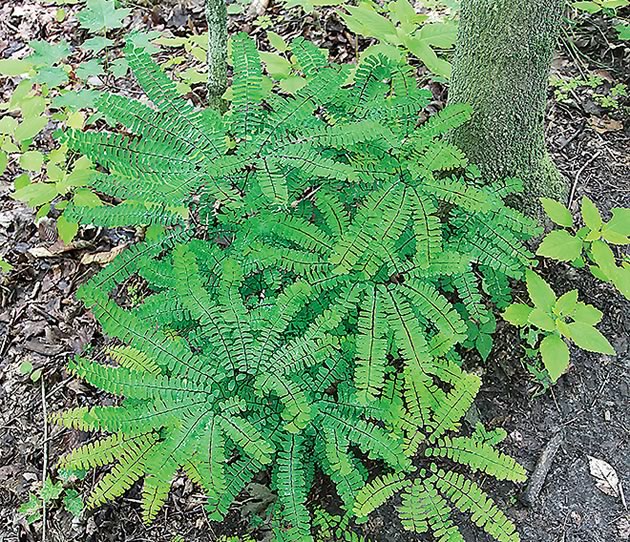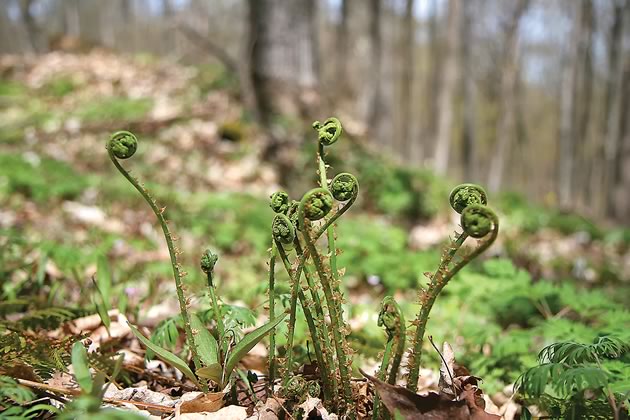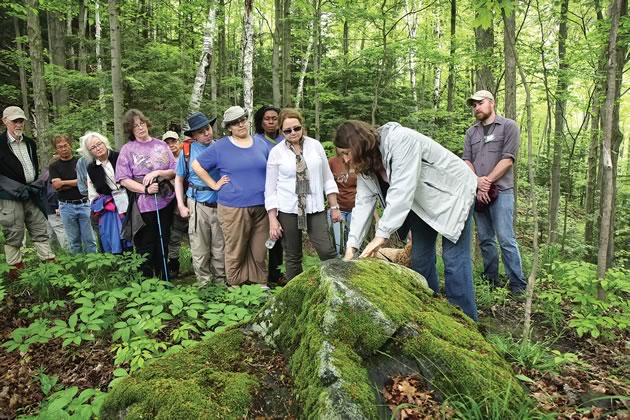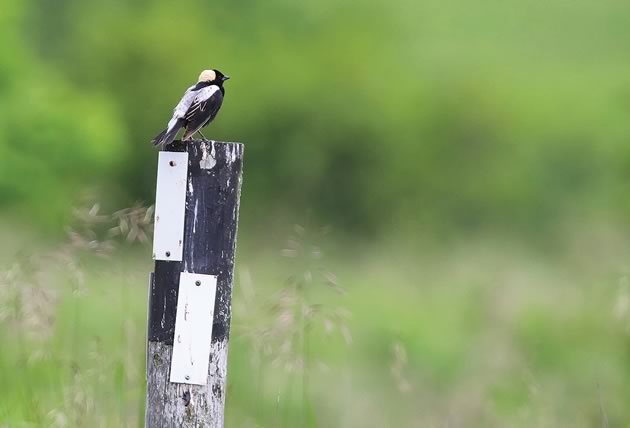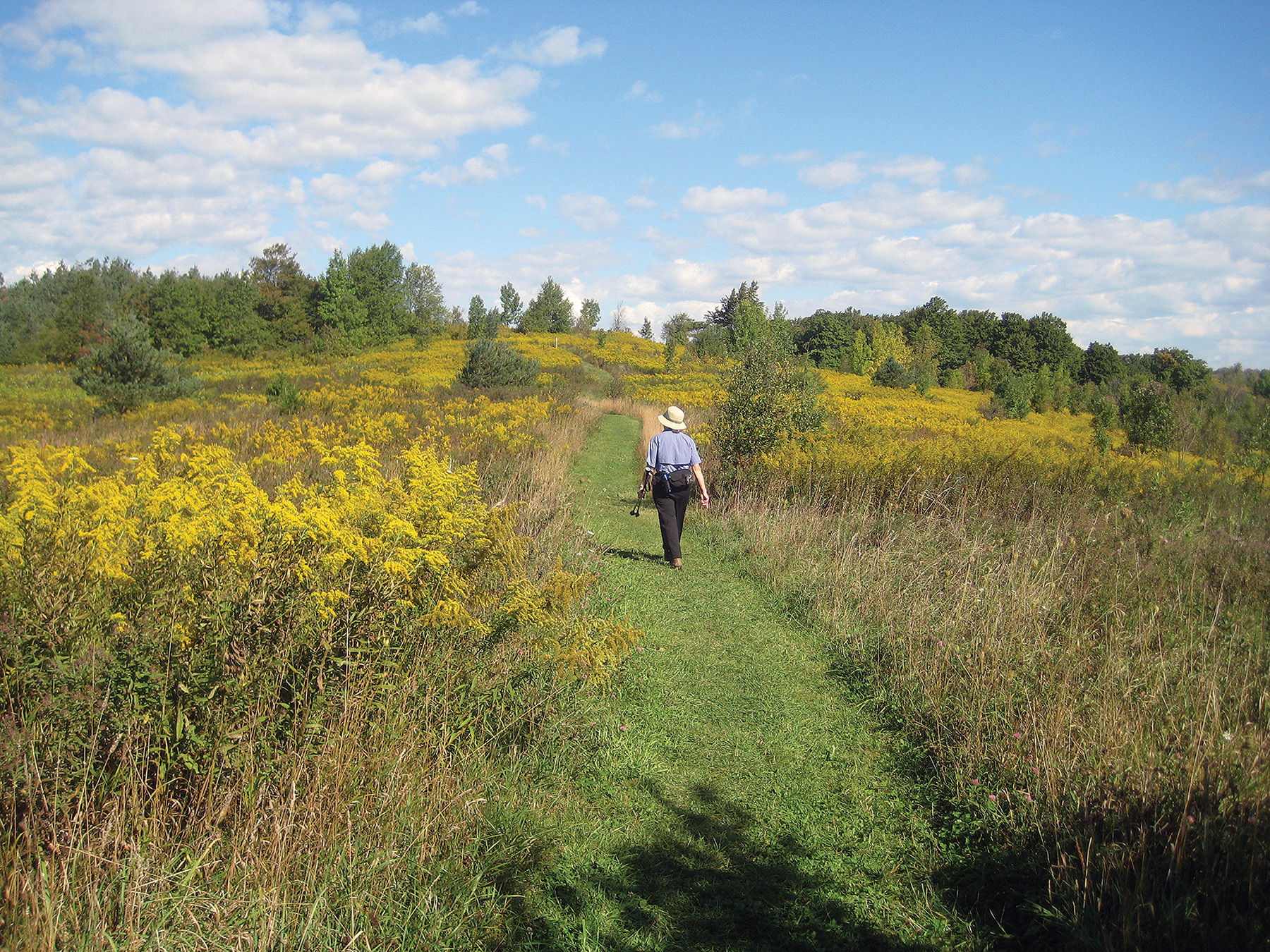An Audacious Idea – The Bruce Trail Turns 50
“What,” Lowes asked, “would you think of a hiking trail winding up the Niagara Escarpment from one end to the other?”
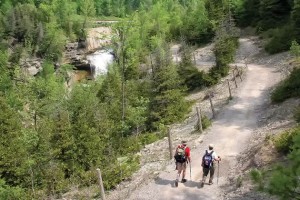
Two hikers follow the main trail overlooking Cataract Falls, one of Caledon’s historical landmarks. Photo by Gary Hall.
It began as one man’s visionary dream. Now the Bruce Trail is a defining feature of Ontario – and 50 years ago, the Caledon section was among the first to be completed.
“We are poor indeed if we are so grasping for every dollar that we cannot afford this narrow strip of land across our province for the good of all,” Ray Lowes, who has been called “the father of the Bruce Trail,” told a conference in 1968. “The simplicity of our request is astounding! We just want a strip of land that will be left alone – not manicured, not landscaped, not serviced by multi-laned highways or ‘parkways,’ and not through new subdivisions. It’s not much to ask. A later generation will demand it.”
Lowes was right. Current generations not only demand the Bruce Trail, which traverses Ontario from Queenston Heights near Niagara Falls to Tobermory at the northern tip of the Bruce Peninsula, but they have also come to believe that the 890-kilometre trail is an integral part of both the landscape and the proud character of the province.
Those who walk the first marked trail in Canada escape the rigid grid pattern of the province’s roads and get inside the Niagara Escarpment. Hikers don’t simply look at nature; they touch the magnificent maple, basswood and beech trees that grace what singer-songwriter Sarah Harmer calls “the backbone – the one that crosses the muscles of the land.” They feel the wind that ripples the surface of abundant vernal ponds, important breeding grounds for many amphibians, including the threatened Jefferson salamander, and hear the rushing brooks that cascade over rocks as old as 430 million years. Features like these contributed to UNESCO’s designation of the escarpment as a World Biosphere Reserve.
Today, the Bruce Trail, like the escarpment itself, may seem as if it has always been there, but in the late 1950s when Lowes came up with the idea of a publicly accessible pathway, his scheme was audacious, a first in a country not yet a century old. The story of how Lowes mentioned his vision to fellow naturalist and Burlington high school teacher Robert Bateman, who had yet to make his name as a wildlife artist, has become as much a part of the lore of the trail as the white blazes that mark the way.
“What,” Lowes asked, “would you think of a hiking trail winding up the Niagara Escarpment from one end to the other?” To which Bateman famously replied, “Well, that’s a great idea, but who’s going to do it?”
Of course, the job of organizing and building the trail fell to the man who suggested it: Lowes, along with the small troupe of like-minded and tenacious volunteers he recruited. Their hard work paid off in 1967, when the trail was formally inaugurated as part of Canada’s centennial celebrations.
Although it took until 1967 to complete the entire trail, the Caledon Hills Bruce Trail Club, which manages the section that stretches from Cheltenham in the south to Mono Centre in the north, was founded in 1964. “The club came to be at a February meeting in my house in Guelph,” says Philip Gosling, who is now 85. On that long-ago day, Gosling agreed to be president until the new club had rounded up a hundred members. When that goal was achieved, he passed along the title and tasks involved.
Named to the Order of Canada last year, Gosling not only helped start the Caledon Hills club, but was also instrumental in creating the entire footpath. As the first trail director of the fledgling Bruce Trail Association – now called the Bruce Trail Conservancy to better reflect its mandate – Gosling travelled the route from one end to the other, talking landowners into allowing the footpath to cross their property.
A self-described naturalist, Gosling took a year’s leave of absence from his job in real estate to work on the task. Covering his expenses with a small grant, which he more than paid back several years later, he laid the groundwork for the trail by meeting farmers, municipal officials, conservation authority representatives and anyone else who might help the association gain access to the route. He was a man on a mission. “For us, it was an emotional thing,” he says. “We wanted to save the Niagara Escarpment for its natural beauty.”
Of all his experiences during that time, Gosling’s favourite story is the “miracle” of the Forks of the Credit. “The only way down the escarpment through the Forks of the Credit,” he explains, “crossed land we thought was owned by Senator Harry Willis.” But the senator hadn’t responded to letters asking for a meeting to discuss the trail. Frustrated, Gosling and Tom East, who later became the Caledon Hills club’s second president, began looking for other options – and discovered an unopened road allowance that included a route down the cliff.
“We couldn’t believe our luck,” Gosling recalls. “It’s a very steep slope and the road allowance happened to run down one of the only places where we could build the trail.” Because the road allowance was a public right of way, Willis’s permission wasn’t needed to make the final link in the Caledon Hills section. “It was a miracle,” says Gosling.
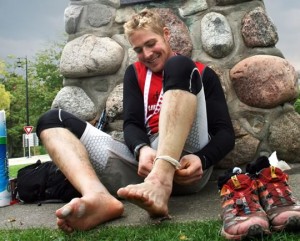
After more than 885 kilometres, Cody Gillies’ feet finally got a break. Photo By Lorrie Bakker
Since those early days, the Caledon Hills club – one of nine that cover the entire trail – has matured and grown. Under current president Jean Kerins the club manages about 70 kilometres of main trail and about another 50 kilometres of side trails. With the help of more than 200 volunteers, the club ensures that the trail is kept shipshape. It also tries to secure portions of the trail to protect it from development and offers regular weekend and Tuesday hikes to anyone interested, including the club’s 850 members. Barbara Sonzogni of Orangeville hikes every Tuesday with a group of friends and says, “We only cancel if it’s 30 degrees above or 30 degrees below. The hikes are that popular.”
Kerins herself gets out on the trail as often as she can. “If I’m lucky,” she says, “I hike two to three times per week.” She adds that she’s a “stop and smell the roses” kind of hiker, who can’t help but pause when she comes to a lookout or other point of interest.
Kerins’ approach to hiking isn’t for everyone. Orangeville resident Cody Gillies, for instance, ran the length of the trail in 2012, raising more than $35,000 for the Headwaters Health Care Foundation. It took him less than 13 days, smashing the previous record by more than a day. (Read about Gillies’ end-to-end run) Compare Gillies’ time to the 30 days or more normally needed to cover the entire distance.
Kerins points out that the club offers hikes of various lengths to suit people of varying ages and fitness levels, as well as those who do and do not want to smell the roses. “Hiking is one of those sports that can be adapted to anyone’s preferences,” she says.
Those who lead the club’s regular hikes are masters at sorting out different hiking styles. The hikes generally attract up to 20 people, and not everyone will walk at a similar pace. “Hiker Sue” Simons, a Bolton resident and club member, says she likes to hike about 15 kilometres, which takes her about four hours. Though Hiker Sue is at the younger end of the hiking demographic, her main reason for hiking is the same as that of many others. “I love the camaraderie of it,” she says. “You get exercise and don’t even notice because you are talking.”
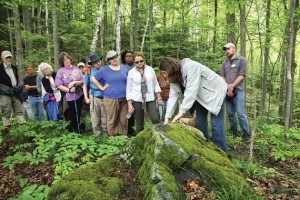
Beth Gilhespy conducts an environmental hike at Hemlock Ridges, a 57-acre Bruce Trail property on the south side of the Hockley Valley. Photo by Gary Hall.
Albert McMaster, who lives in Alton, is another of the club’s regular hikers. Like Simons, McMaster lists good company as a key reason for his enthusiasm. “I live most of my life on my own,” he explains in a lilting accent that gives away his Irish heritage. “It’s nice to have people to talk to.”
Though McMaster’s favoured hikes last about two hours, he gets out two or three times a week and occasionally completes the longer 20- to 25-kilometre distances of some club hikes. Five years ago he joined about 50 keeners for the club’s annual Thanksgiving hike, covering Caledon’s entire 70-kilometre section over the three-day weekend – and he received a badge to prove it.
As Hiker Sue and others point out, hiking is a great form of exercise and an opportunity to meet new friends and catch up with old acquaintances. By walking the Bruce Trail, you also become intimate with the landscape in a manner not possible inside a car or atop a bicycle. Ray Lowes, who died in 2007 at the age of 96, knew that on foot you can pat an old-growth maple that stands guard along a favourite trail. Or you might have lunch on a stretch of the Credit River seldom visited by humans.
And if you are a smell-the-roses kind of hiker like Jean Kerins, you will certainly stop to read the small trailside plaque that recognizes Philip Gosling’s role in creating the Bruce Trail. From this spot atop the cliffs not far from the Devil’s Pulpit, be sure to gaze out over one of the most spectacular vistas along the entire length of the Niagara Escarpment. As the miracle of the Forks of the Credit demonstrates, this view was secured because a group of dreamers had not only a vision, but also the wherewithal to get the job done.
More Info
Caledon Hills Bruce Trail Club Celebrates Its 50th
To celebrate its first 50 years, the Caledon Hills Bruce Trail Club has planned a number of special activities in 2014. There is a theatre night in the spring and a fall train excursion. The club will also dedicate a nature reserve to Philip Gosling. Details about forthcoming anniversary events, as well as information about the club’s hikes and membership, are available at www.caledonbrucetrail.org.
Dufferin Hi-Land Bruce Trail Club
Extending from Mono Centre in the south to Lavender in the north, the Dufferin Hi-Land section of the Bruce Trail is also located in Headwaters. Over its 51 kilometres, it passes through Mono Cliffs Provincial Park, Boyne Valley Provincial Park and the Pine River Fishing Area. The club, which holds Tuesday and “regular” hikes, celebrates its 50th anniversary in 2015. Membership, hiking and other information is available at www.dufferinbrucetrailclub.org.
Bruce Trail Conservancy Membership
The Bruce Trail Conservancy is a volunteer-run, charitable organization that receives very little government support. Most of the BTC’s revenues come from membership fees, individual and corporate donors, and foundations. So if you use the trail, please join the organization’s more than 8,000 other members.
To become a member, you join one of nine clubs or, like Caledon Club president Jean Kerins, you can join all nine clubs. The BTC sells the excellent Bruce Trail Reference Guide ($30.96 for members or $36.96 for non-members) – which some refer to as the “Bruce Trail Bible.” It includes information about the trail and offers detailed maps which can be removed from the guide and carried by hikers.
The benefits of membership include
- a tax receipt
- information about organized hikes
- a subscription to Bruce Trail Magazine, the BTC’s quarterly publication
- club newsletters and email updates
- invitations to special BTC events
- discounted access to some conservation areas
- discounts on BTC products such as Bruce Trail Reference Guide
- discounts from retail partners
- voting privileges
Visit www.brucetrail.org for more information.



